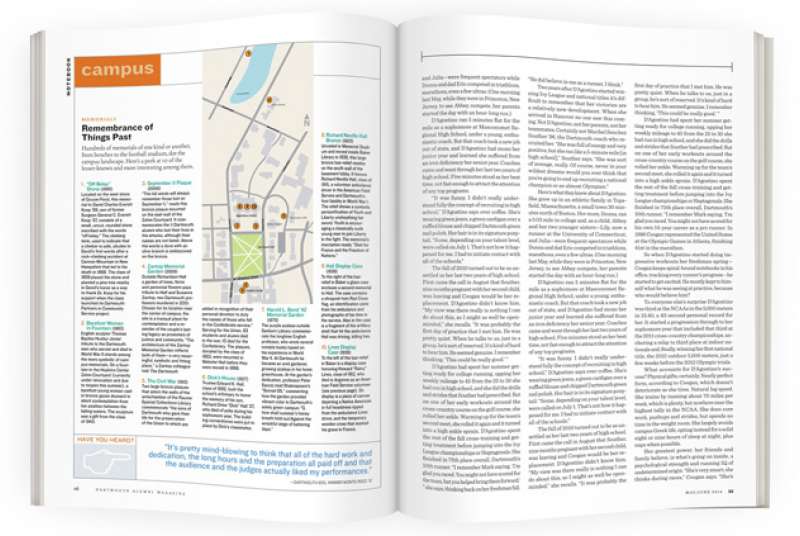
Remembrance of Things Past
1. “Off Belay” Stone (1995)
Located on the west shore of Occom Pond, this memorial to David Charles Everett Koop ’69, son of former Surgeon General C. Everett Koop ’37, consists of a small, uncut, rounded stone inscribed with the words “off belay.” The climbing term, used to indicate that a climber is safe, alludes to David’s first words after a rock-climbing accident at Cannon Mountain in New Hampshire that led to his death in 1968. The class of 1959 placed the stone and planted a pine tree nearby in David’s honor as a way to thank Dr. Koop for his support when the class launched its Dartmouth Partners in Community Service project.
2. Barefoot Woman in Fountain (1963)
English sculptor Thomas Bayliss Huxley-Jones’ tribute to the Dartmouth men who served and died in World War II stands among the more symbolic of campus memorials. On a fountain in the Hopkins Center Zahm Courtyard (currently under renovation and due to reopen this summer), a barefoot young woman cast in bronze gazes skyward in silent contemplation from her position between the falling waters. The sculpture was a gift from the class of 1943.
3. September 11 Plaque (2009)
“The hill winds will always remember those lost on September 11,” reads this bronze plaque mounted on the east wall of the Zahm Courtyard. It commemorates the 11 Dartmouth alumni who lost their lives in the attacks, although their names are not listed. Above the words a dove with an olive branch is emblazoned on the bronze.
4. Zantop Memorial Garden (2009)
Outside Richardson Hall a garden of trees, ferns and perennial flowers pays tribute to Half and Susanne Zantop, two Dartmouth professors murdered in 2001. Chosen for its location near the center of campus, the site is a tranquil place for contemplation and a reminder of the couple’s lasting legacy as promoters of justice and community. “The architecture of the Zantop Memorial Garden reflects both of them—a very meaningful, symbolic and fitting place,” a Zantop colleague told The Dartmouth.
5. The Civil War (1913)
Two large bronze plaques that adorn the walls of the antechamber of the Rauner Special Collections Library commemorate “the sons of Dartmouth who gave their life for the preservation of the Union to which are added in recognition of their personal devotion to duty the names of those who fell in the Confederate service.” Serving for the Union, 63 students and alumni died in the war; 10 died for the Confederacy. The plaques, donated by the class of 1863, were mounted in Webster Hall before they were moved in 1999.
6. Dick’s House (1927)
Trustee Edward K. Hall, class of 1892, built the school’s infirmary to honor the memory of his son, Richard Drew “Dick” Hall ’27, who died of polio during his sophomore year. The building cornerstones were put in place by Dick’s classmates.
7. Harold L. Bond ’42 Memorial Garden (1970)
The purple azaleas outside Sanborn Library commemorate the longtime English professor, who wrote several notable books based on his experience in World War II. At Dartmouth he became an avid gardener, growing azaleas in his home greenhouse. At the garden’s dedication, professor Peter Saccio read Shakespeare’s “Sonnet 65,” commenting how the garden provided vibrant color to Dartmouth’s solely green campus: “O, how shall summer’s honey breath hold out/Against the wreckful siege of battering days.”
8. Richard Neville Hall Bronze (1923)
Unveiled in Memorial Stadium and moved inside Baker Library in 1936, this large bronze bas-relief resides on the south wall of the basement lobby. It honors Richard Neville Hall, class of 1915, a volunteer ambulance driver in the American Field Service and Dartmouth’s first fatality in World War I. The relief shows a symbolic personification of Youth and Liberty unsheathing her sword. Youth is encouraging a classically nude young man to join Liberty in the fight. The memorial’s inscription reads: “Died for France and the Freedom of Nations.”
9. Hall Display Case (1939)
To the right of the bas-relief in Baker a glass case encloses a second memorial to Hall. The case contains a shrapnel-torn Red Cross flag, an identification plate from his ambulance and photographs of his time in the service. Also in the case is a fragment of the artillery shell that hit the ambulance Hall was driving, killing him.
10. Lines Display Case (1939)
To the left of the bas-relief in Baker is a display case honoring Howard “Rainy” Lines, class of 1912, who died in Argonne as an American Field Service volunteer. On display is a piece of canvas depicting a Native American in full headdress ripped from the ambulance Lines drove, and the temporary wooden cross that marked his grave in France.










